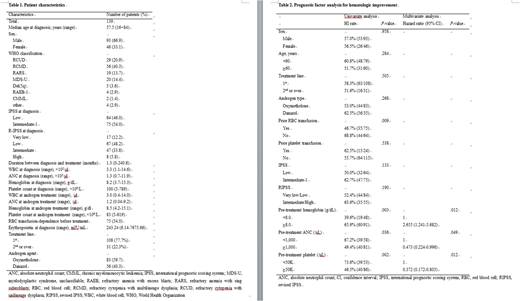Abstract
Background
Improvement of cytopenia is one of the primary treatment purposes for patients with the lower-risk myelodysplastic syndrome (MDS). Androgens have been used for the treatment of aplastic anemia, immune thrombocytopenia, and telomere diseases. In this retrospective study, we aimed to evaluate the efficacy of androgen therapy in lower-risk MDS.
Methods
We analyzed the data of 139 patients who received androgens (danazol or oxymetholone) for treatment of cytopenia between February 1997 and May 2018. All patients had the international prognostic scoring system low or intermediate-1 risk at the time of androgen therapy. The assessment of hematologic improvement (HI) was based on the international working group response criteria for MDS.
Results
Androgens (oxymetholone for 83 patients and danazol for 56) were given as first (n=108, 77.7%) or over second (n=31, 22.3%)-line treatment for MDS (Table 1). The time interval between diagnosis and androgen treatment was median 1.3 months (range, 0-240.6), and 75 patients (54.0%) were red blood cell (RBC) transfusion-dependent before treatment. The dose intensity of oxymetholone and danazol was 79 and 385 mg/day respectively, and the median treatment duration was 5.8 months (range, 0.9-92.2). Seventy-nine patients (56.8%) achieved HI at any lineage: 29.0% for erythroid (HI-E), 51.9% for platelet (HI-P), and 60.5% for neutrophil (HI-N). The median time to HI following androgen therapy was 4.1 months (range, 0.6-124.5) for HI-E, 1.7 (range, 0.4-40.4) for HI-P, and 1.8 (range, 0.2-8.4) for HI-N. In univariate analysis, presence of RBC transfusion-dependence (46.7% vs. 68.8%, P=.009), pre-treatment low hemoglobin (45.2% vs. 74.5%, P=.001), high platelet count (46.5% vs. 73.6%, P=.002), and high neutrophil count (4.94% vs. 67.2%, P=.036) were associated with lower HI rate (Table 2). In multivariate analysis, pre-treatment low hemoglobin, high platelet count, and high neutrophil count remained as significant factors for lower HI rate (Table 2). During the median follow-up duration of survivors of 40.8 months (95% confidence interval [CI], 38.0-67.5), the estimated 5-year overall survival (OS) and acute myeloid leukemia-free survival was 68.8% and 67.7%, respectively. Achievement of HI was associated with longer OS (hazard ratio, 0.346; 95% CI, 0.174-0.688). There were no significant differences in HI and OS rates between danazol and oxymetholone.
Conclusion
Our data suggest that androgen can be a reasonable treatment option for lower-risk MDS patients with significant cytopenia. Prospective studies are warranted to investigate the efficacy of androgen therapy in lower-risk MDS.
No relevant conflicts of interest to declare.
Author notes
Asterisk with author names denotes non-ASH members.


This feature is available to Subscribers Only
Sign In or Create an Account Close Modal